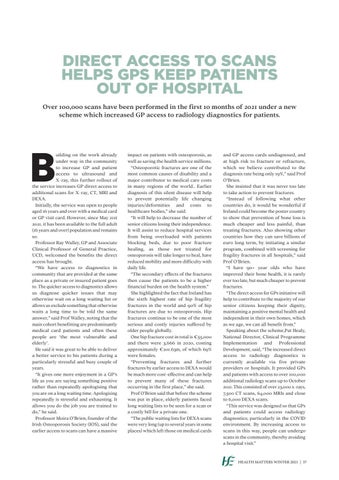DIRECT ACCESS TO SCANS HELPS GPS KEEP PATIENTS OUT OF HOSPITAL Over 100,000 scans have been performed in the first 10 months of 2021 under a new scheme which increased GP access to radiology diagnostics for patients.
B
uilding on the work already under way in the community to increase GP and patient access to ultrasound and X-ray, this further rollout of the service increases GP direct access to additional scans for X-ray, CT, MRI and DEXA. Initially, the service was open to people aged 16 years and over with a medical card or GP visit card. However, since May 21st 2021, it has been available to the full adult (16 years and over) population and remains so. Professor Ray Walley, GP and Associate Clinical Professor of General Practice, UCD, welcomed the benefits the direct access has brought. “We have access to diagnostics in community that are provided at the same place as a private or insured patient goes to. The quicker access to diagnostics allows us diagnose quicker issues that may otherwise wait on a long waiting list or allows us exclude something that otherwise waits a long time to be told the same answer,” said Prof Walley, noting that the main cohort benefitting are predominantly medical card patients and often these people are ‘the most vulnerable and elderly’. He said it was great to be able to deliver a better service to his patients during a particularly stressful and busy couple of years. “It gives one more enjoyment in a GP’s life as you are saying something positive rather than repeatedly apologising that you are on a long waiting time. Apologising repeatedly is stressful and exhausting. It allows you do the job you are trained to do,” he said. Professor Moira O’Brien, founder of the Irish Osteoporosis Society (IOS), said the earlier access to scans can have a massive
impact on patients with osteoporosis, as well as saving the health service millions. “Osteoporotic fractures are one of the most common causes of disability and a major contributor to medical care costs in many regions of the world.. Earlier diagnosis of this silent disease will help to prevent potentially life changing injuries/deformities and costs to healthcare bodies,” she said. “It will help to decrease the number of senior citizens losing their independence. It will assist to reduce hospital services from being overloaded with patients blocking beds, due to poor fracture healing, as those not treated for osteoporosis will take longer to heal, have reduced mobility and more difficulty with daily life. “The secondary effects of the fractures then cause the patients to be a higher financial burden on the health system.” She highlighted the fact that Ireland has the sixth highest rate of hip fragility fractures in the world and 90% of hip fractures are due to osteoporosis. Hip fractures continue to be one of the most serious and costly injuries suffered by older people globally. One hip fracture cost in total is €55,000 and there were 3,666 in 2020, costing approximately €201.63m, of which 69% were females. “Preventing fractures and further fractures by earlier access to DEXA would be much more cost-effective and can help to prevent many of these fractures occurring in the first place,” she said. Prof O’Brien said that before the scheme was put in place, elderly patients faced long waiting lists to be seen for a scan or a costly bill for a private one. “The public waiting lists for DEXA scans were very long (up to several years in some places) which left those on medical cards
and GP access cards undiagnosed, and at high risk to fracture or refracture, which we believe contributed to the diagnosis rate being only 19%,” said Prof O’Brien. She insisted that it was never too late to take action to prevent fractures. “Instead of following what other countries do, it would be wonderful if Ireland could become the poster country to show that prevention of bone loss is much cheaper and less painful, than treating fractures. Also showing other countries how they can save billions of euro long term, by initiating a similar program, combined with screening for fragility fractures in all hospitals,” said Prof O’Brien. “I have 90+ year olds who have improved their bone health, it is rarely ever too late, but much cheaper to prevent fractures. “The direct access for GPs initiative will help to contribute to the majority of our senior citizens keeping their dignity, maintaining a positive mental health and independent in their own homes, which as we age, we can all benefit from.” Speaking about the scheme,Pat Healy, National Director, Clinical Programme Implementation and Professional Development, said, “The increased direct access to radiology diagnostics is currently available via five private providers or hospitals. It provided GPs and patients with access to over 100,000 additional radiology scans up to October 2021. This consisted of over 23,000 x-rays, 7,500 CT scans, 64,000 MRIs and close to 6,000 DEXA scans. “This service was designed so that GPs and patients could access radiology diagnostics; particularly in the COVID environment. By increasing access to scans in this way, people can undergo scans in the community, thereby avoiding a hospital visit.”
HEALTH MATTERS WINTER 2021 | 37
















































